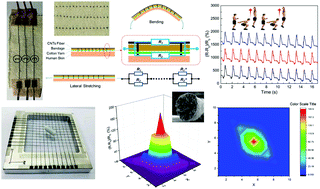Highly stretchable multi-walled carbon nanotube/thermoplastic polyurethane composite fibers for ultrasensitive, wearable strain sensors†
Abstract
Here, we report a novel highly sensitive wearable strain sensor based on a highly stretchable multi-walled carbon nanotube (MWCNT)/Thermoplastic Polyurethane (TPU) fiber obtained via a wet spinning process. The MWCNT/TPU fiber showed the highest tensile strength and ultra-high sensitivity with a gauge factor (GF) of approximately 2800 in the strain range of 5–100%. Due to its high strain sensitivity of conductivity, this CNT-reinforced composite fiber was able to be used to monitor the weight and shape of an object based on the 2D mapping of resistance changes. Moreover, the composite fiber was able to be stitched onto a highly stretchable elastic bandage using a sewing machine to produce a wearable strain sensor for the detection of diverse human motions. We also demonstrated the detection of finger motion by fabricating a smart glove at the joints. Due to its scalable production process, high stretchability and ultrasensitivity, the MWCNT/TPU fiber may open a new avenue for the fabrication of next-generation stretchable textile-based strain sensors.



 Please wait while we load your content...
Please wait while we load your content...